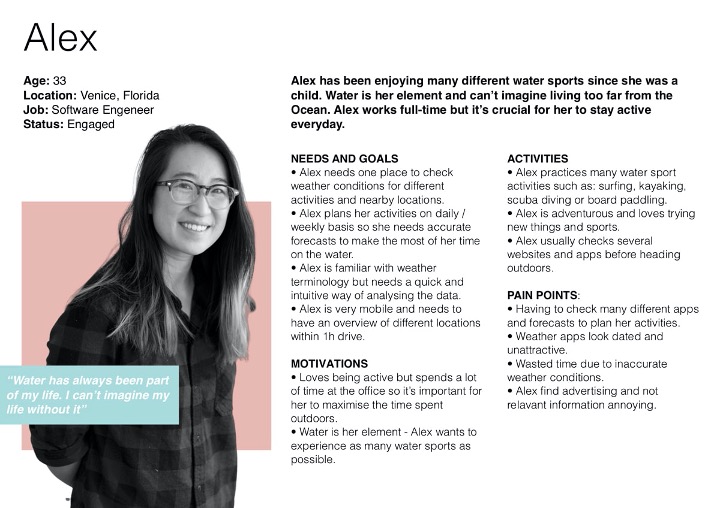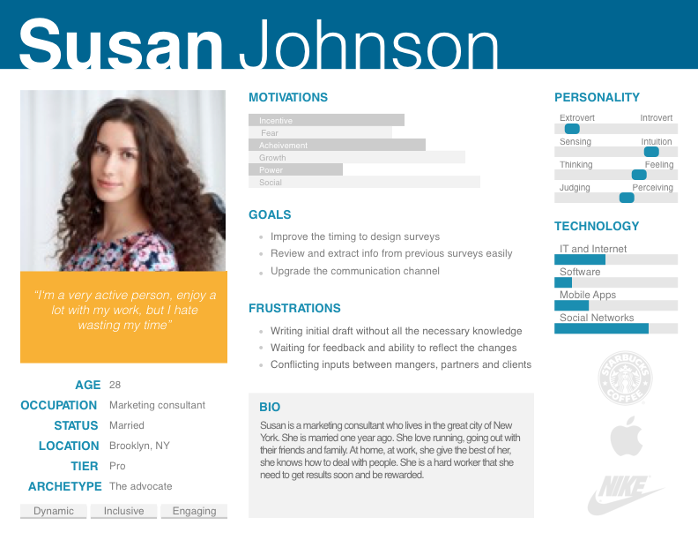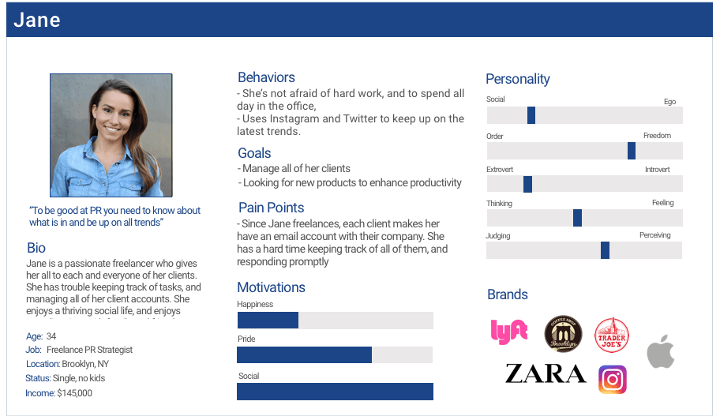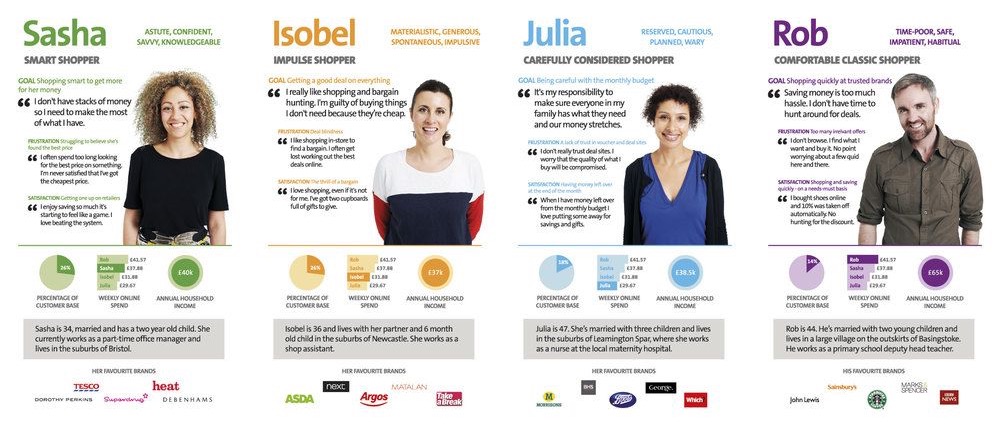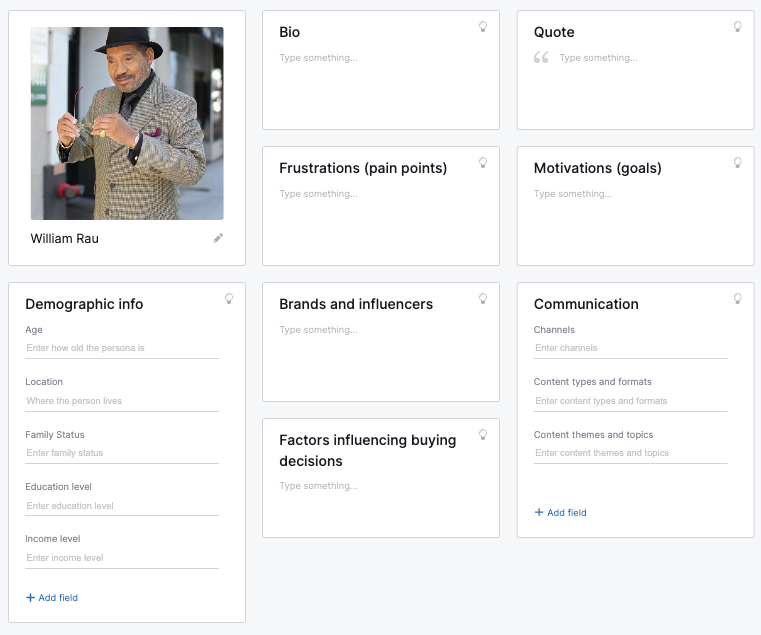Personas are fictional characters, which you create based upon your research in order to represent the different user types that might use your service, product, site, or brand in a similar way (current or future).
The use of Personas is “marketing trendy,” but you also seem them in use by advertising, public relations, social media, non-profits, website designers, etc.,
Many of the more advanced social media tools have free templates you can fill in. They also have more elaborate online tools in their paid version you can use.
Without doing this you are likely to generalize and just try to reach Millennials, Gen X, etc. that means you are treating everyone within a 15-year age group AS THE SAME – Hence, you are not targeting someone, you are targeting everyone!
And that’s NOT a good thing to do. Instead of talking to someone, it feels like you’re talking “at” them or over their heads. This means you are less likely to seem authentic, less trustworthy, and definitely not putting yourself in the position to have a conversation or two-way communication.
A persona is just a marketing segment you might be interested in using, and hopefully it’s not based entirely on demographics, or cohorts (Gen Z, Gen Y, Gen X, etc)
Don’t just “guess” at your personas or segments. If the criteria you used is a gut feeling and can’t be backed up – Well, congratulations. You’ve built a segment that when you target with a message, they won’t respond.
Why? Because you were in-authentic and made up someone who isn’t really there!
Using a Persona for your target means you’re trying to think about who they really are and what motivates them.
It’s also easier to write messages for someone when you can imagine them as a person; what they’re doing at a specific time of the day; what are their highs and lows.
- Makes it easier to think about who you are trying to reach if you see them as a person, not as just a bullet list of demographics.
- Makes it easier to create for them or create your media plan “flowchart” of your stories if you can imagine who they are, what they are doing in the afternoon, evening, etc.
- Makes for a nice visual in a plan (video or book)
- Also might want to make some anti-personas for those you haven’t decided are your best path to reach.
More on Personas
- Try to look beyond just demographics to include lifestyles, hobbies, other interests.
- Sometimes people include other things they like**
- Try to think about whether they are an emotional knee-jerk, impulsive person, or if they overly plan ahead.
- Are they afraid to try new things, or are they adventuresome and assume some risk when trying new things?
- Who do they rely on for “proof” ? Or do they need it?
- Are they doing this for themselves, or for family, or to fit in with friends?**
- Sometimes people use first names:
- John, Emma, etc.
- Sometimes people use job titles:
- Developer, Accountant, Line Worker
- Sometimes people use names such as:
- Impulse Shopper, Careful Donor, etc
Anti-personas
- An anti-persona – otherwise known as a negative or exclusionary persona – is the type of person you specifically don’t want to target.
- Sometimes in a campaign plans book you mention them to really focus on who you are trying to reach versus those that probably wouldn’t be interested, or might need to be reached in a very different way.
Personas are sometimes referred to as:
- Buyer persona
- Target persona
- Consumer persona
- Donor persona
- Oversimplification: Creating personas involves generalizing and categorizing individuals into specific groups based on common traits. This oversimplification may lead to overlooking the complexity and diversity within each segment, potentially missing out on important nuances in customer behavior and preferences.
- Inaccurate Representation: If the personas are based on incomplete or outdated data, assumptions, or biases, they may not accurately represent the actual target audience. Relying on inaccurate personas can lead to misguided marketing strategies and ineffective campaigns.
- Static Nature: Real customers are dynamic and can evolve over time. Personas, however, are often fixed and may not reflect changes in customer preferences, behaviors, or demographics. Regular updates and revisions are necessary to keep personas relevant and effective.
- Confirmation Bias: Marketers may sometimes unconsciously interpret new data or feedback from customers to fit the pre-existing personas, leading to confirmation bias. This can hinder a more open-minded understanding of customer needs and behaviors.
- Overemphasis on Demographics: While demographics provide valuable insights, focusing solely on them can overlook other crucial factors influencing customer behavior, such as psychographics, motivations, and life experiences.
A final reminder!
Again, if you make up some phantom persona by being flippant, you will be:
- Chasing after a person who doesn’t exist, or isn’t a real target.
- Ignoring a group of important people NOT in one of your personas that you should be targeting!
That’s wasting time and money.
Careful and Prepared Shopper – Methodical Mike
Personality: Mike is a 40-year-old engineer who values organization and efficiency. He approaches shopping with a methodical and analytical mindset, treating it almost like a project. Mike believes in making well-reasoned decisions and takes pride in his ability to find the best products at the best prices.
Motivations: Mike’s primary motivation is to optimize his purchases to get the highest value for his money. He thoroughly researches products, reads expert reviews, and compares prices before making a buying decision. Quality, durability, and functionality are key factors for him, and he is willing to invest time to find the best options.
Shopping Behavior: Mike is tech-savvy and relies on online research and comparison websites to streamline his shopping process. He creates detailed lists, sets budgets, and always carries a list of items he needs when visiting physical stores. He avoids impulsive purchases and prefers to stick to his planned shopping agenda.
In-the-Moment Shopper – Spontaneous Sarah
Personality: Sarah is a 26-year-old free-spirited and adventurous individual. She enjoys living in the present moment and dislikes overthinking her shopping decisions. Sarah is easily captivated by in-store displays and vivid advertisements. She loves exploring new products and experiences on a whim.
Motivations: Sarah’s main motivation is the excitement of discovering something new and different. She seeks products that provide immediate enjoyment or solve a specific problem she encounters during her shopping trip. For her, shopping is an opportunity to indulge in spontaneity and personal indulgence.
Shopping Behavior: Sarah prefers physical stores over online shopping because she likes the sensory experience of browsing through products and interacting with friendly store staff. Eye-catching displays, limited-time offers, and special promotions easily sway her into making unplanned purchases.
Budget-Conscious Shopper – Thrifty Tom
Personality: Tom is a 35-year-old family man with a pragmatic and frugal approach to shopping. He is responsible for managing his household finances and seeks to provide the best for his family while staying within a budget. Tom is skilled at finding discounts, deals, and bargains without compromising on quality.
Motivations: Tom’s primary motivation is to stretch his budget and ensure the best value for his family’s needs. He focuses on finding practical solutions and prioritizes savings to fit into his household budget. He avoids impulse buying and opts for products that offer durability and value for money.
Shopping Behavior: Tom is well-versed in online research and utilizes price comparison websites, coupon apps, and customer reviews to find the best deals. He enjoys shopping during sale seasons and is open to buying in bulk when the price is right. Tom actively searches for ways to save on everyday items and stays loyal to stores that consistently offer good prices.
It’s probably easy to see a major difference between Sarah and the others.
The differences between Mike and Tom might be harder to see.
Mike is definitely looking for a deal, but he’s doing this more for the long-term, and he derives satisfaction from knowing he found the best one, which further validates his methodical personality. By comparison, Tom needs to make the best decision purely on current, or short-term, economics.
If we went back and looked at Maslow’s Hierarchy, these two gentlemen are in very different spaces – with Tom rooted in a lower level, whereas Mike is using his approach to be one aspect of self-actualization.
Mike is definitely a Hamlet personality, whereas Sarah is definitely Laertes. Tom fits somewhere in between, but is probably closer to Hamlet, albeit for different reasons than Mike.
There is NO template that’s universally used. Decide what works for you.
On the first set of personas, with the handwritten comments and colorful backgrounds, the company didn’t focus on quantitative details. Instead it’s a series of descriptive motivators and descriptives.
The rest of these examples include some combination of quantitative and qualitative information. Many including sliders, or percentages. Nearly all include motivators, pain points, and a bio.
Most include a job title. These aren’t meant to be definitive, they’re just to get you thinking about whether they’re their own boss, work a 9-to-5 job, are hourly, etc. People with little leadership or management in their professional career often respond differently to IMC messages that stress individuality or “put yourself in charge,” as they see little of this during their work hours.
Below are two online persona generators I use in classes. Both SEM Rush and Hubspot allow you to customize the fields based on what you’re trying to achieve.
You can also find tons of MS Word, InDesign, PowerPoint online. The button below takes you to an assortment of these:


